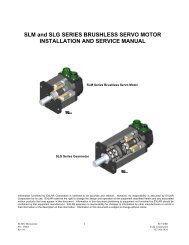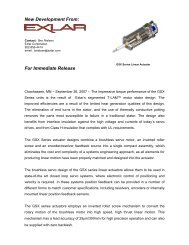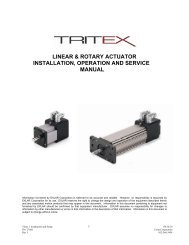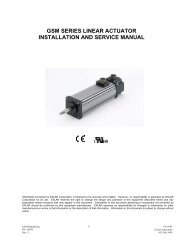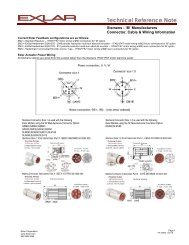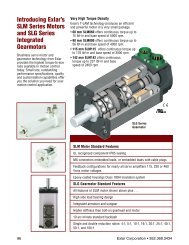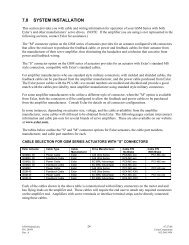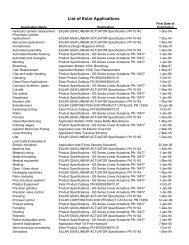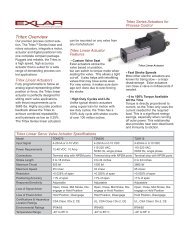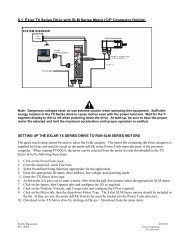You also want an ePaper? Increase the reach of your titles
YUMPU automatically turns print PDFs into web optimized ePapers that Google loves.
Engineering Reference<br />
Sizing and Selection of <strong>Exlar</strong><br />
Linear and Rotary Actuators<br />
Move Profiles<br />
The first step in analyzing a motion control application and<br />
selecting an actuator is to determine the required move<br />
profile. This move profile is based on the distance to be<br />
traveled and the amount of time available in which to make<br />
that move. The calculations below can help you determine<br />
your move profile.<br />
Each motion device will have a maximum speed that it can<br />
achieve for each specific load capacity. This maximum speed<br />
will determine which type of motion profile can be used to<br />
complete the move. Two common types of move profiles are<br />
trapezoidal and triangular. If the average velocity of the profile,<br />
is less than half the max. velocity of the actuator, then<br />
triangular profiles can be used. Triangular Profiles result in the<br />
lowest possible acceleration and deceleration. Otherwise a<br />
trapezoidal profile can be used. The trapezoidal profile below<br />
with 3 equal divisions will result in 25% lower maximum speed<br />
and 12.5% higher acceleration and deceleration. This is<br />
commonly called a 1/3 trapezoidal profile.<br />
Linear Move Profile Calculations<br />
vmax = max.velocity-in/sec (m/sec)<br />
Vavg = avg. velocity-in/sec (m/sec)<br />
tacc = acceleration time (sec)<br />
tdec = deceleration time (sec)<br />
tcv = constant velocity (sec)<br />
ttotal = total move time (sec)<br />
acc = accel-in/sec 2 (m/sec 2 )<br />
dec = decel-in/sec 2 (m/sec 2 )<br />
cv = constant vel.-in/sec (m/sec)<br />
D = total move distance-in (m)<br />
or revolutions (rotary)<br />
Standard Equations<br />
Vavg = D / ttotal<br />
If tacc = tdec Then: Vmax =<br />
(ttotal/(ttotal-tacc)(Vavg)<br />
and<br />
D = Area under profile curve<br />
D = (1⁄2(tacc+tdec)+tcv)(Vmax)<br />
The following pages give the<br />
required formulas that allow you<br />
to select the proper <strong>Exlar</strong> linear or<br />
rotary actuator for your<br />
application.<br />
The first calculation explanation is<br />
for determining the required V max<br />
thrust in a linear application. The<br />
V avg<br />
second provides the necessary<br />
acc<br />
equations for determining the<br />
torque required from a linear or<br />
rotary application. For rotary<br />
applications this includes the use<br />
of reductions through belts or<br />
gears, and for linear applications,<br />
through screws.<br />
Pages are included to allow you to<br />
enter your data and easily perform<br />
the required calculations. You can<br />
also describe your application<br />
graphically and fax it to <strong>Exlar</strong> for<br />
sizing. Reference tables for<br />
common unit conversions and<br />
motion system constants are<br />
included at the end of the section.<br />
Velocity (in/sec)<br />
t acc<br />
V max<br />
V avg<br />
Trapezoidal Move Profile<br />
Velocity (in/sec)<br />
cv<br />
acc<br />
t cv t acc<br />
t total<br />
cv<br />
t dec<br />
dec<br />
t cv<br />
t total<br />
Trapezoidal Equations<br />
If tacc = tcv = tdec Then:<br />
Vmax = 1.5 (Vavg)<br />
D = (2⁄3) (ttotal) (Vmax)<br />
acc = dec = Vmax<br />
tacc<br />
dec<br />
time (sec)<br />
t dec<br />
time (sec)<br />
V max<br />
V avg<br />
Triangular Move Profile<br />
Velocity (in/sec)<br />
acc<br />
t acc<br />
V max<br />
V avg<br />
Velocity (in/sec)<br />
acc<br />
t total<br />
t acc<br />
t dec<br />
t total<br />
Triangular Equations<br />
dec<br />
If tacc = ttotal/2 Then:<br />
Vmax = 2.0 (Vavg)<br />
D = (1⁄2) (ttotal) (Vmax)<br />
acc = dec = Vmax<br />
tacc<br />
time (sec)<br />
t dec<br />
dec<br />
time (sec)<br />
146 9.52.500.6200 | www.exlar.com



